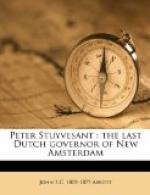“this capital is adorned with so many noble buildings, at the expense of so many good and faithful inhabitants, principally Netherlanders, that it nearly excels any other place in North America. Were it duly fortified it would instil fear into any envious neighbors. It would protect both the East and the North rivers, the surrounding villages and farms, as well as full ten thousand inhabitants who would soon flock to this province, where thousands of acres of land remain wild and uncultivated. It would become the granary of fatherland. Yes, if permitted to abide in peace this land will become an emporium to fatherland by its growing plantations.”
In accordance with this memorial, heavy taxes were imposed and large contributions subscribed to enlarge and strengthen the fortifications. A militia of two hundred men was organized, and one hundred and sixty were enlisted as regular soldiers.
CHAPTER XIII.
HOSTILE MEASURES COMMENCED.
John Scott and his Movements.—Losses of the Dutch.—The First General Assembly.—Action of the Home Government.—Peace with the Indians.—Arrest of John Scott.—Governor Winthrop’s visit to Long Island.—Sailing of the Fleet.—Preparations for War.—The False Dispatches.—Arrival of the Fleet.—The Summons to Surrender.
Governor Stuyvesant, with much anxiety of mind, kept a vigilant eye upon the proceedings of John Scott, on Long Island. Some praised the governor for the forbearance he had exhibited under the provoking circumstances. Others severely blamed him for his course, which they pronounced to be cowardly and disgraceful to the nation.
By the terms of the Convention, concluded between the Dutch delegates and John Scott, it was agreed that the English villages, on the western part of Long Island, should remain unmolested under English rule, for the space of one year, until the king of England and the States-General of Holland should have time to settle the question in dispute. In the meantime the English were to have free access to all the Dutch towns on the island, and on the mainland, for purposes of trade; and the Dutch were to enjoy the same privilege in visiting the English towns.
These terms were to be presented to Governor Stuyvesant for his rejection or approval. Deciding to ratify them he took with him an escort of ten men, and proceeded to Hempstead, on the third day of March, 1664. Here he met the President, John Scott, with delegates from the English towns, and the agreement was ratified.
The Dutch had now lost, one after another, every portion of territory which the English had assailed. The whole valley of the Connecticut river had been surrendered to the English. Westchester was entirely in their possession. And now the important towns of Flushing, Jamaica, Hempstead and Gravesend were yielded up to them. The whole of Long Island was also peremptorily claimed by the English, with the declaration that if any resistance were made to their taking possession of it, they would seize the valley of the Hudson and the whole of New Netherland.




